Overview of the public assembly
The country has eased up to welcome tourists from countries with low risk without mandatory quarantine since 1 November 2021 as General Prayut Chan-ocha said in a press conference on 11 October 2021 and his initial announcement in June to reopen the country in 120 days. Nevertheless, on 29 September 2021, the Government Gazette’s website published the Notification on the extension of the declaration of the State of Emergency, for the 14th time, from 1 October until 30 November 2021. Thailand has thus been subject to the State of Emergency for one year and eight months. Later on 28 October 2021, prior to the country’s reopening, the Government Gazette published the Notification of the chief officer in charge of the resolution of the state of emergency concerning national security on “prohibition of public assembly, or activity, or illegal assembly that risks spreading the Coronavirus (Covid-19) (no. 13) taking effect from 1 November onward. Meanwhile, the Centre for COVID-19 Situation Administration (CCSA) still retains the curfew ban from 23.00-03.00, exclusively in maximum and strict control zones, which have now reduced to seven provinces including Chanthaburi, Tak, Nakhon Si Thammarat, Narathiwat, Pattani, Yala and Songkhla.
Throughout October 2021, there have been at least 110 public assemblies countrywide. Their main demand is the removal of General Prayut Chan-ocha as Prime Minister and the restoration of the right to bail for people imprisoned for political reasons. The Resistant Citizen resumed its Stand Stop Imprisonment since 16 August 2021 for 76 days running (as of 31 October) and they continued to stand there at Arkong Lawn in front of the Supreme Court. Similarly, the “Stand Stop the Tyranny” has been organized by We, The people in Chiang Mai. The other demands including constitutional amendment and the repeal of the Penal Code’s Section 112 continue to appear in all campaigns. The independent groups have also been converged at Din Daeng Intersection including the Thalugaz from 1-6 October 2021. The authorities have adapted the tactic to occupy the area at the Din Daeng Intersection. They were all clad in kai color uniforms signifying that they belonged to the Metropolitan Police Bureau and were equipped with live bullets. Given the heavy presence of the officials at the Din Daeng Intersection and Soi Ton Poh, it has stopped the independent Thalugaz from gathering there since 7 October 2021.
Toward late October 2021, on 24 October 2021, prior to the Stand Stop Imprisonment at Arkong Lawn in front of the Supreme Court, the Ratsadon Group had a press conference about the forthcoming public assembly on 31 October 2021, “Ratsadon’s will to repeal 112”. It would be a rally to advocate for the repeal of the Penal Code’s Section 112 in the name of the “Committee for the Campaign to Repeal Section 112”. The group plans to launch online petition campaign for eligible voters at least 10,000 of them to sign up to propose the repeal of the Penal Code’s Section 112 to the Parliament. On 31 October 2021, the first day of the campaign, it took place at the Ratchaprasong intersection.
How force is used to disperse the assemblies, the number and examples of injured persons and arrestees including children and youth, media and observers
Even though it is clearly stipulated in the General comment No. 37 issued by virtue of Article 21 of the International Covenant on Civil and Political Rights (ICCPR) that dispersal of protest could only be carried out only in exceptional circumstances including when the public assembly is no longer deemed peaceful, or when clear evidence can be established to prove that the situation cannot be addressed by the use of serious violence of the authorities and thereby the authorities are compelled to resort to other more reasonable and proportionate responses. Even though the conditions are met for the authorities to disperse the protest, the public officials are still obliged to act within the bound of the law and in compliance with international human rights standards
Nevertheless, in October, despite a decline of public assemblies at the Din Daeng Intersection, the number of prosecution in the aftermath of the public assemblies has risen. Despite the decline of crowd dispersal, the violent crackdown against the protesters continued unabated. The authorities still retained the use of kettling including the crowd dispersal on 6 October 2021 where the officials cordoned off Soi Ton Poh by the Din Daeng Flats. Also, during the public assembly on 29 October 2021, kittling was adopted and arrests made against the protesters in front of the Din Daeng Police Station. This is not compatible with the General Comment no. 37 which clearly prescribes that necessary law enforcement measures targeted against specific individuals are often preferable to containment. Particular care must be taken to contain, as far as possible, only people linked directly to violence and to limit the duration of the containment to the minimum necessary. Where containment is used indiscriminately or punitively, it violates the right of peaceful assembly, and may also violate other rights such as freedom from arbitrary detention and freedom of movement.
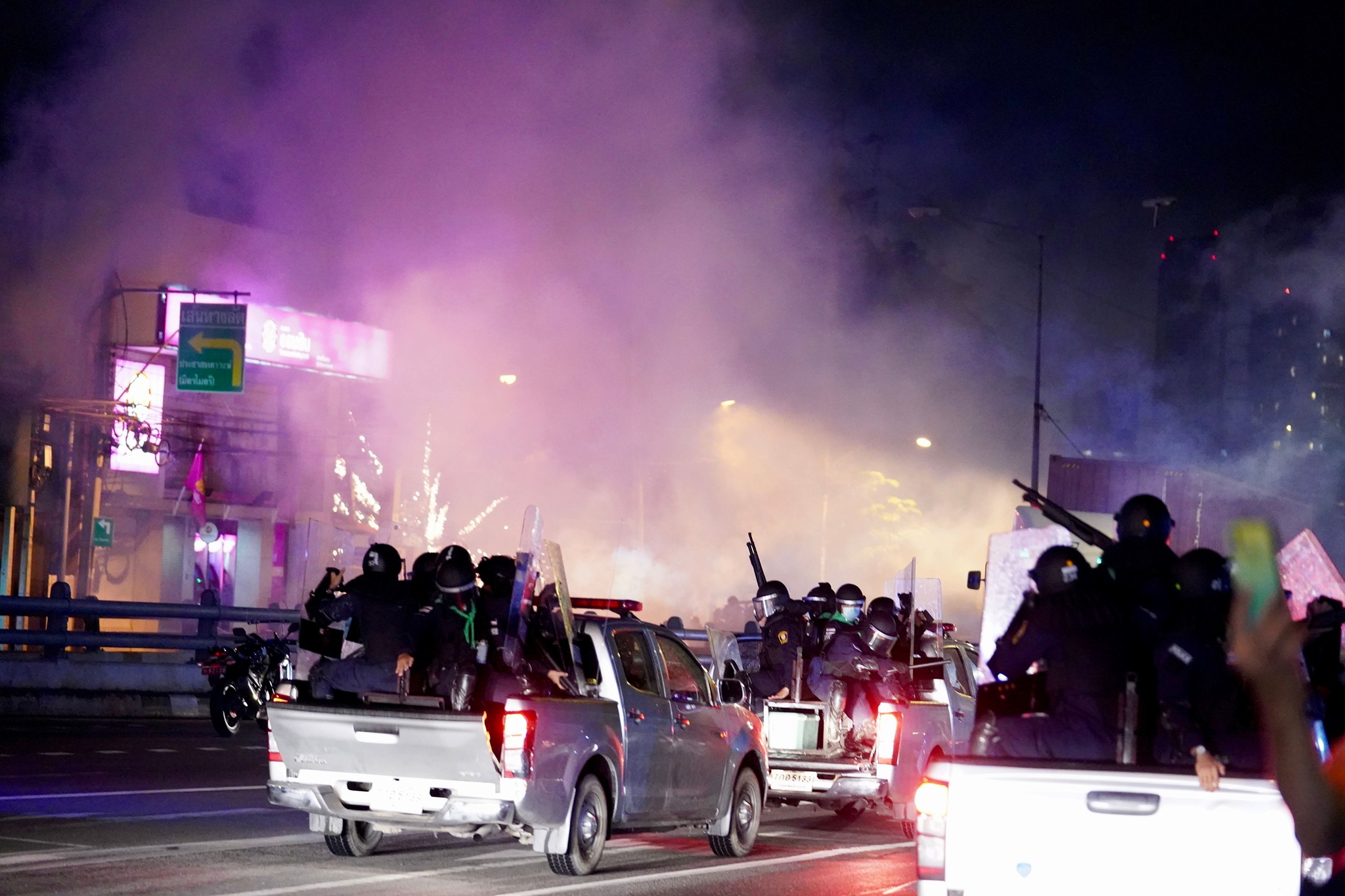
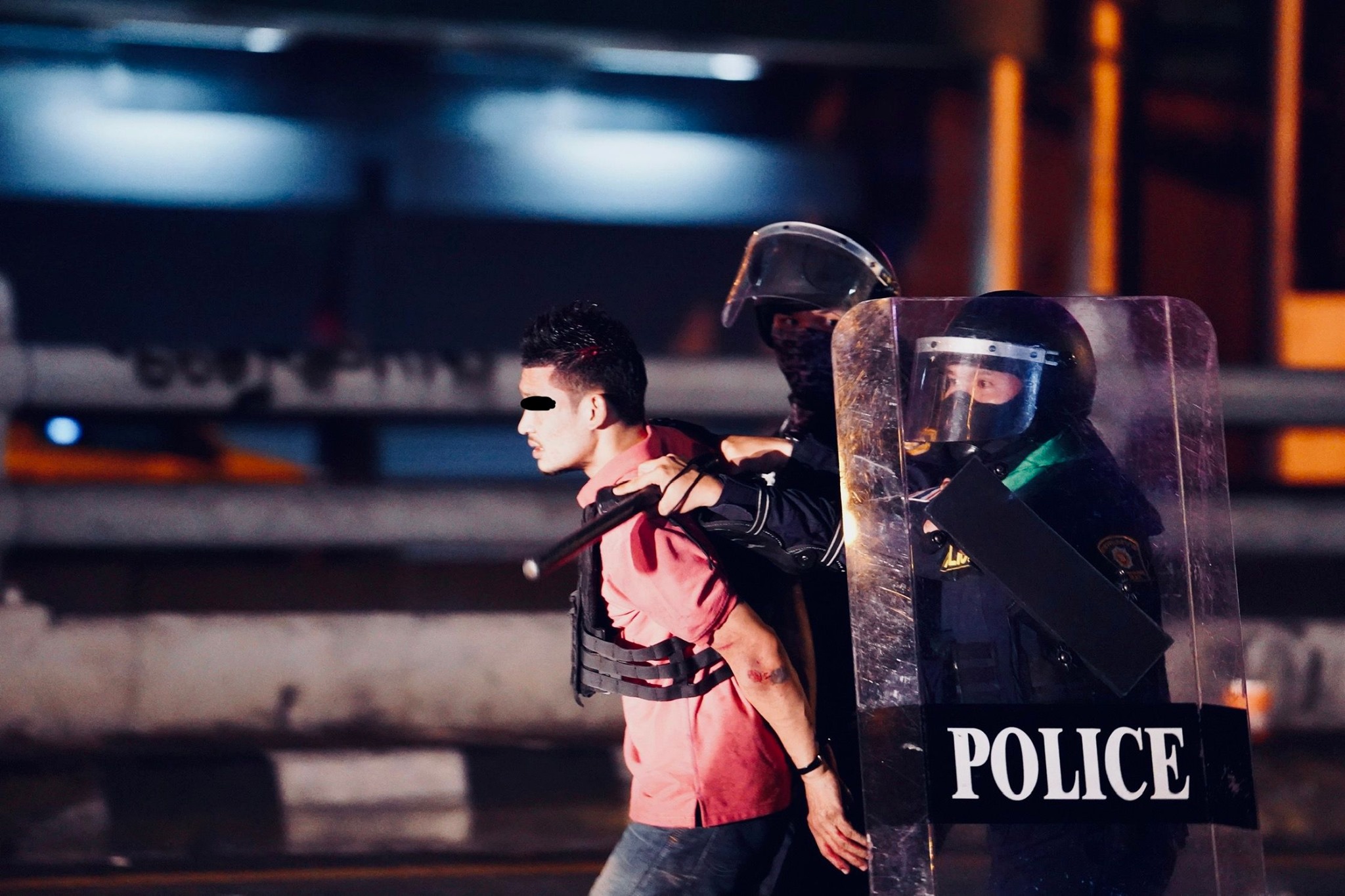
The dispersal of the public assembly on 6 October 2021. Photo by Prachatai.com
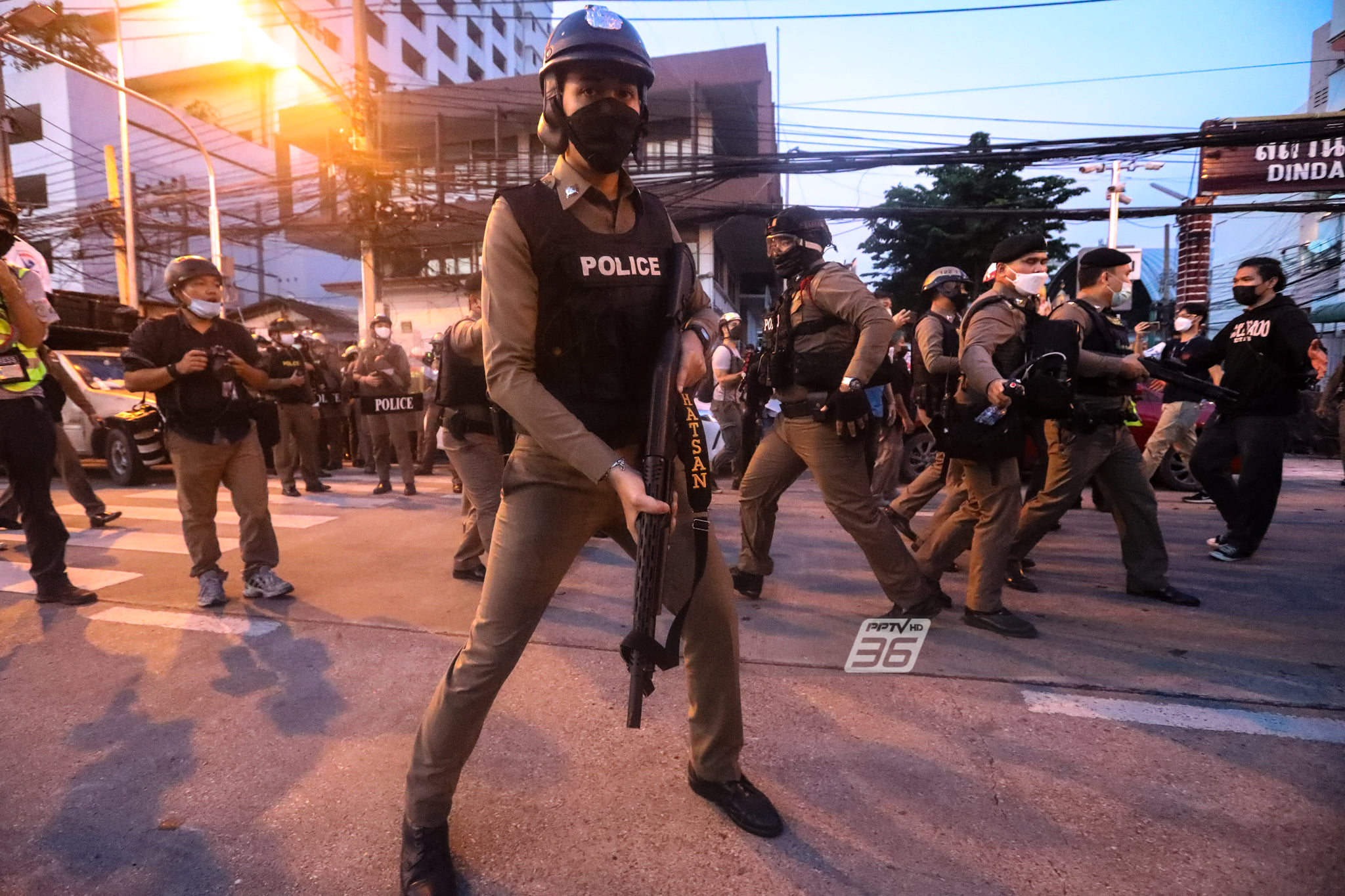
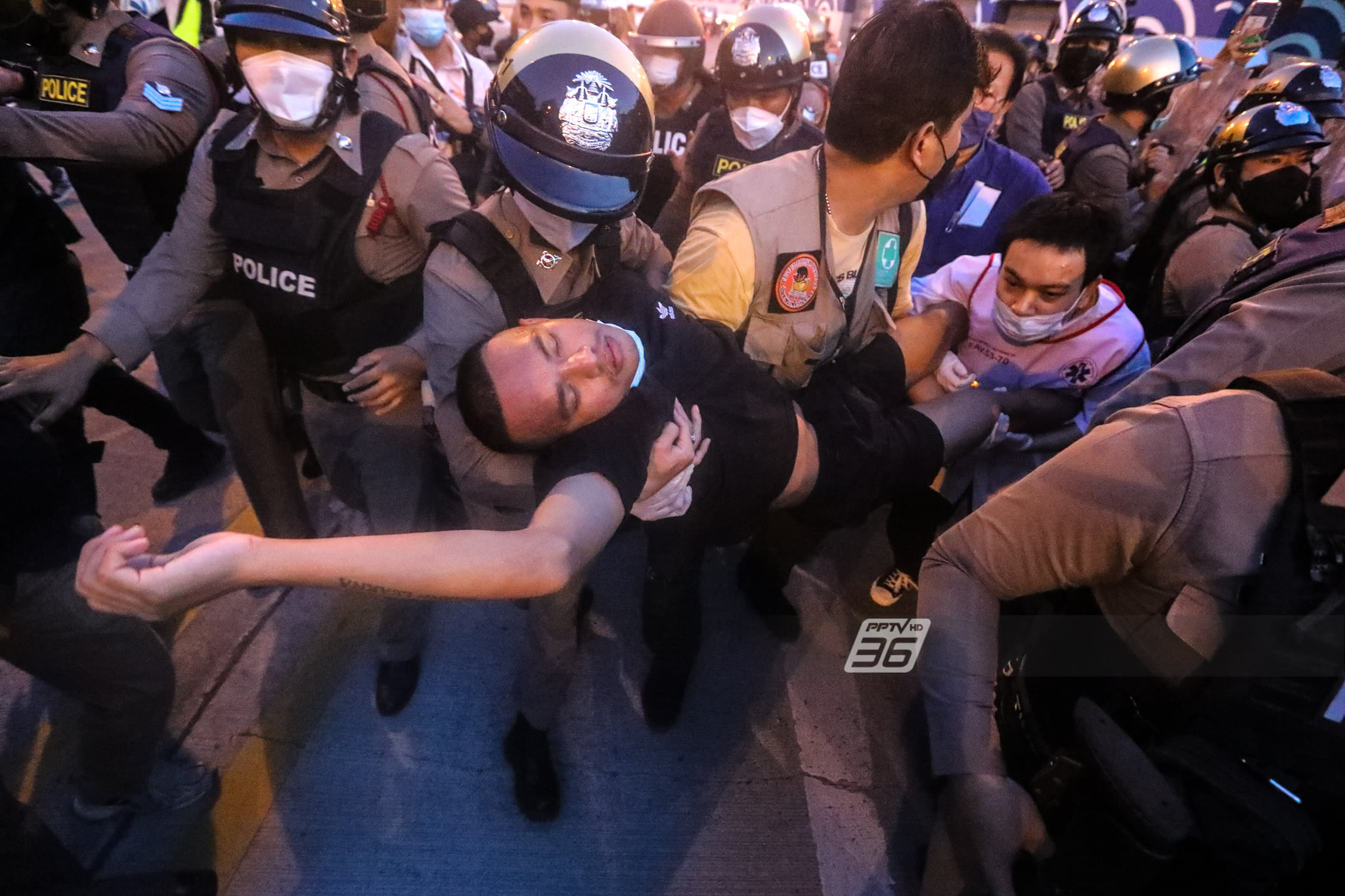
During the public assembly on 29 October 2021, kittling was adopted and arrests made against the protesters in front of the Din Daeng Police Station. Photo by PPTV HD 36
Moreover, the operations in October remained similar to those in September including the dispersal of public assembly which caused a wider implication on local residents. It demonstrates how the officials have acted clearly unnecessarily. In addition, there have been mass and indiscriminate arrests , particularly during and after the public assemblies. An effort was also made by the authorities to isolate unaffiliated media or freelance media from the assembly venues, to arrest the media and non-participants, all of which constituted an arbitrary action. Moreover, many arrests have led to physical injuries among the arrestees. In October 2021, 45 children were arrested. At least 39 of them were charged in 24 cases, while three were not. 28 of them were arrested unlawfully without warrants, while 11 faced arrest warrants and three have been summoned to answer to the charges. The youngest among them was 11.
A number of individuals have been injured during the dispersal of public assembly and the arrests including at least six children and youth. This includes the public assembly on 6 October 2021 when at least three children got injured including sustaining bodily bruises. One of them, a 16-year-old-child was hit in his head with the gun handle by the police causing him to sustain two wounds. His fingers were cracked making loud noise and causing his hand to swell and making it difficult to move. The back of his hand was burned with cigarette leaving a small wound. During the public assembly on 15 October 2021, a child was injured during the raid and execution of arrest warrant at his home. After he was released, it was found he sustained some cuts and scratches on his neck, behind his left ear and his back. No reasons were given as to the causes of his injuries. In October, a child died. He was a 15-year-old-child who died on 28 October 2021 after spending two and a half months in ICU at the Rajavithi Hospital. He was shot on 16 August 2021 in front of the Din Daeng Police Station and the bullet was lodged in his brain stem. An investigation is going on to bring the assailant to justice.
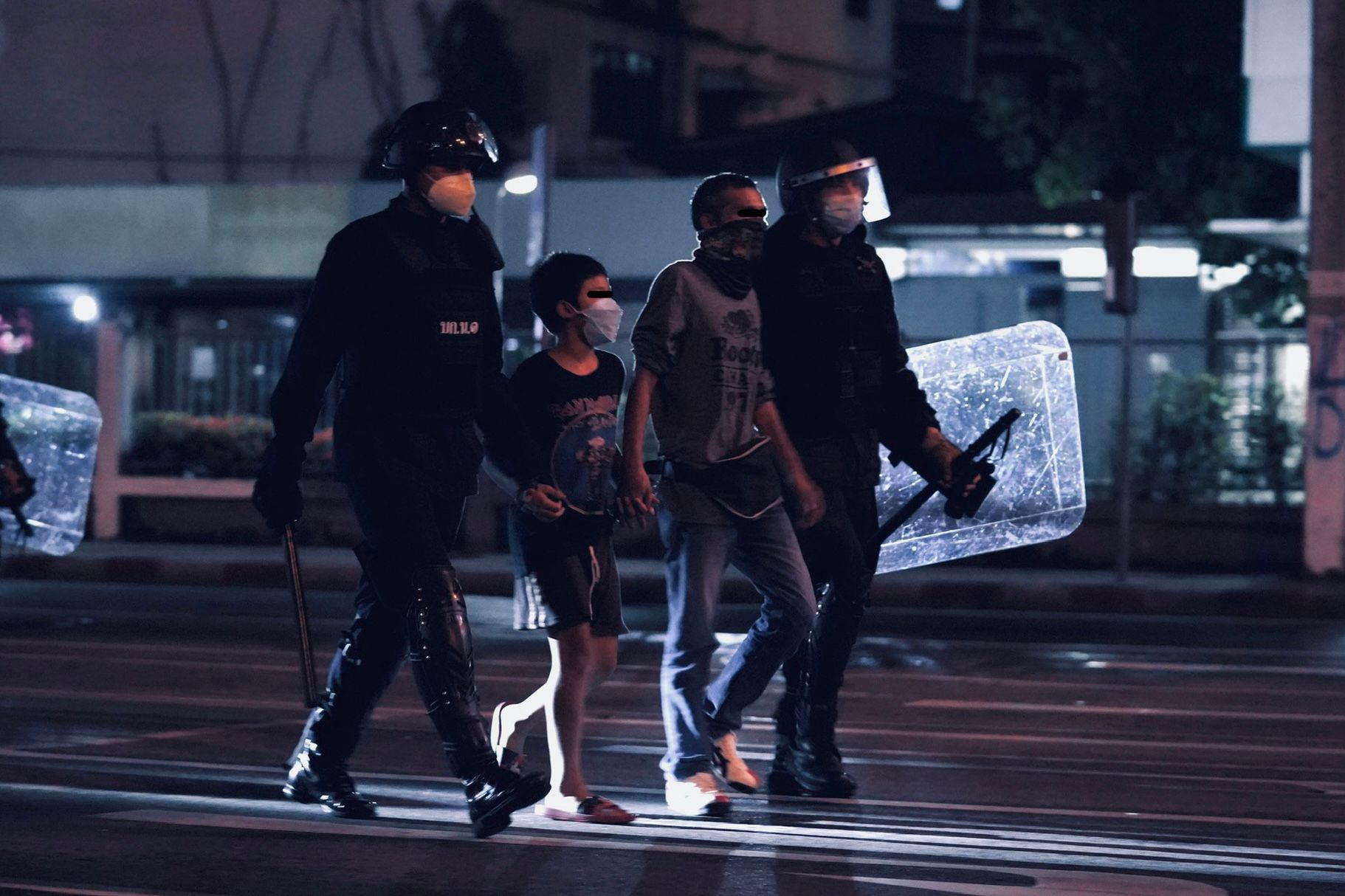
The dispersal of the public assembly on 6 October 2021. Photo by Prachatai.com
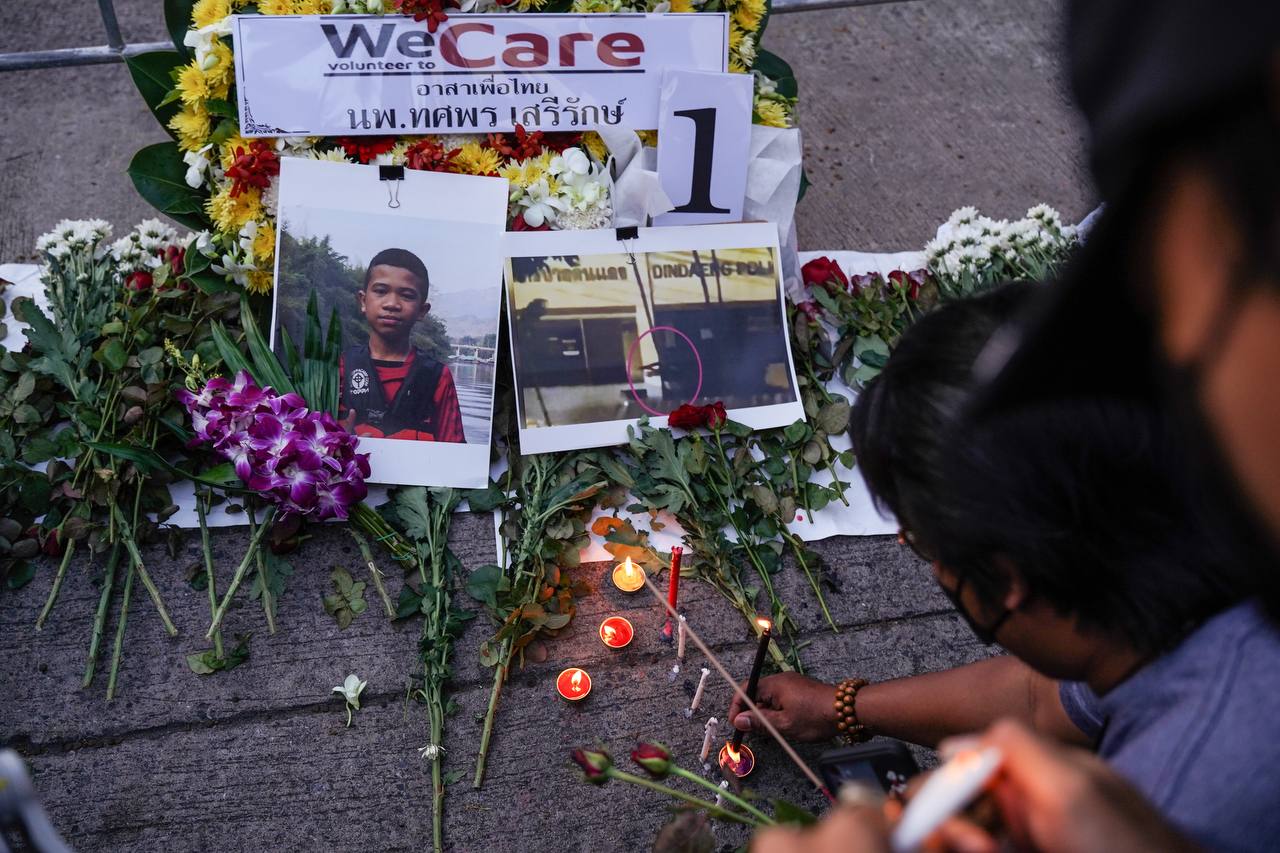
In October, a child died. He was a 15-year-old-child who died on 28 October 2021 after being shot on 16 August 2021. Photo by Mob Data Thailand
The nature of the use of force by the officials to disperse the protest, the number and example of injured persons and arrestees including children and youth, media and observers
if it becomes absolutely necessary to use force including the dispersal of public assembly, it must comply with the fundamental principles of legality, necessity, proportionality, precaution and non-discrimination. In other word, the authorities are prohibited from using force to arbitrarily disperse a public assembly. Therefore, Section 21 of the Public Assembly Act 2015 sets out the criteria for the police officials or competent officials to use their discretion to police the public assemblies and the court is allowed to review the order to disperse the crowd.
Nevertheless, even though Thailand is set to reopen the country in November, the Emergency Decree is still imposed at least until the end of the month. Thailand has thus been subject to the State of Emergency for one year and eight months. The Emergency Decree and the curfew ban have been invoked to criminalize public gatherings or public assemblies. It has also been invoked to disperse the public assemblies including the use of water cannon laced with tear gas, the shooting of rubber bullet and tear gas to immediately stop the gathering. Kettling and arrests have also been made, particularly at Sam Liam Din Daeng where the officials kettled the protesters paving the way for rapid mobile units to get in and arrest the participants. In such incidences, even though the organizers of public assemblies or the participants have failed to act according certain requirements of domestic laws concerning public assemblies including the Public Administration in Emergency Situations, but their actions are still covered by Article 21 if the ICCPR. The fact that an assembly provokes or may provoke a hostile reaction from members of the public against participants, as a general rule, does not justify restriction; the assembly.
In addition, given the change of tactics by the police officials to occupy the area around Din Daeng Intersection since 7 October, the officials clad in khaki color uniform with live bullets are still deployed there every day to kettle the area, an act of which is excessive, during the time the Thalugaz members are often gathered. Meanwhile, the Thai Lawyers for Human Rights (TLHR) reports that during 1-30 October 2021, at least 155 individuals were arrested from the public assemblies including 34 who are from 15-18, at least 12 who are younger than 15 and at least seven who got injured.12 The arrests and injuries from the dispersal of public assembly can be described as follows;
The dispersal of public assembly on 4 October 2021 of the Thalugaz, the crowd control officials kettled the protesters in Mitra Maitree Rd. around 21.00. Then on 00.00, it was reported that the crowd control officials and SWAT unit have raided the Flats to look for the escaping protesters at night time. As a result, 26 were arrested and more than three sustained injuries during the public assembly.

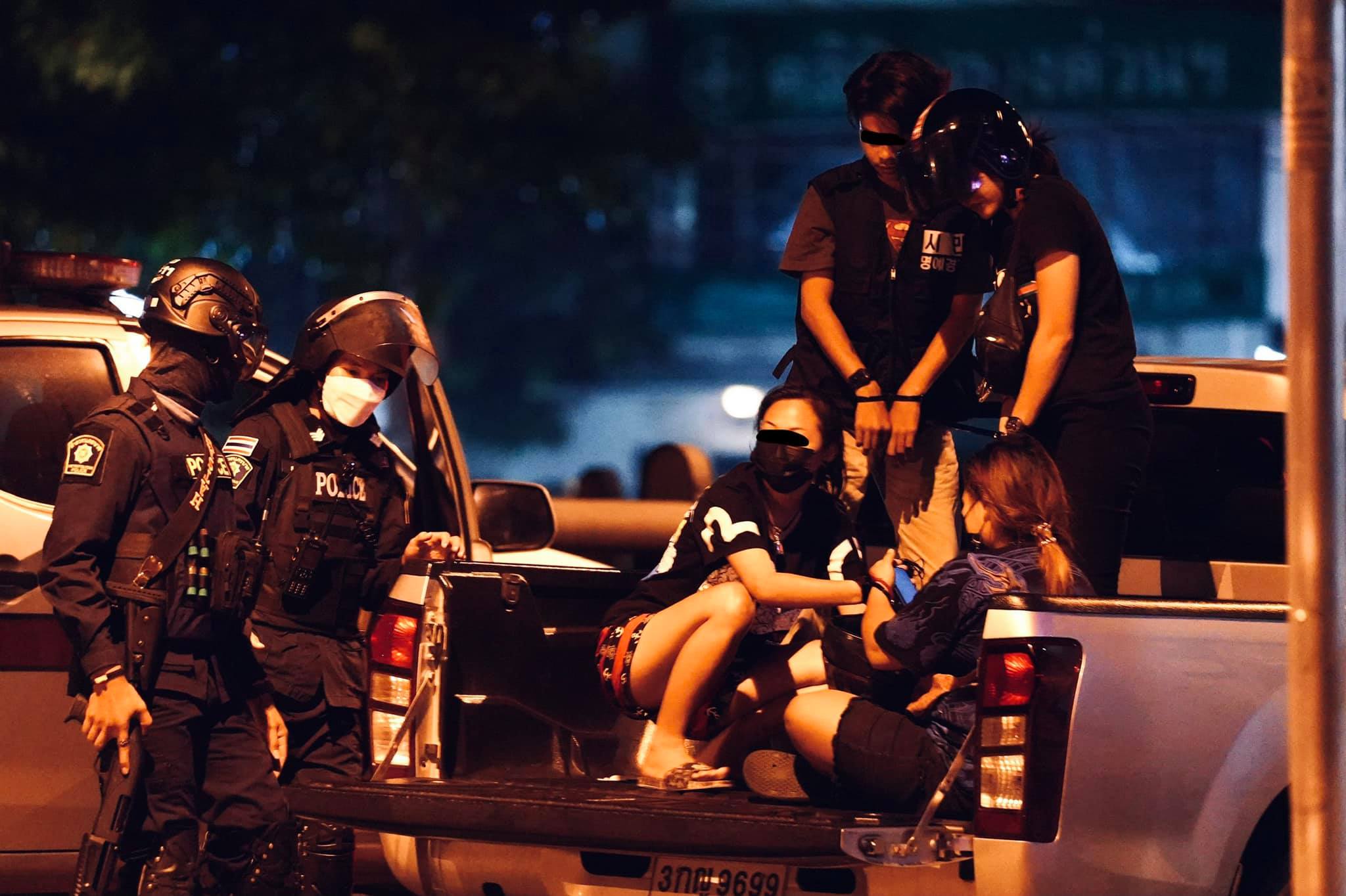
The dispersal of the public assembly on 4 October 2021. Photo by Kai Maew Cheese
The dispersal of public assembly on 6 October 2021 and the continuing arrests until 7 October 2021 against the Thalugaz at the Din Daeng Intersection, more than 70 participants were arrested, 68 of whom were charged. Some have sustained injuries during the arrests. In addition, during the that time, TLHR reported that the police have denied the arrestees’ access to lawyer for 12 hours.
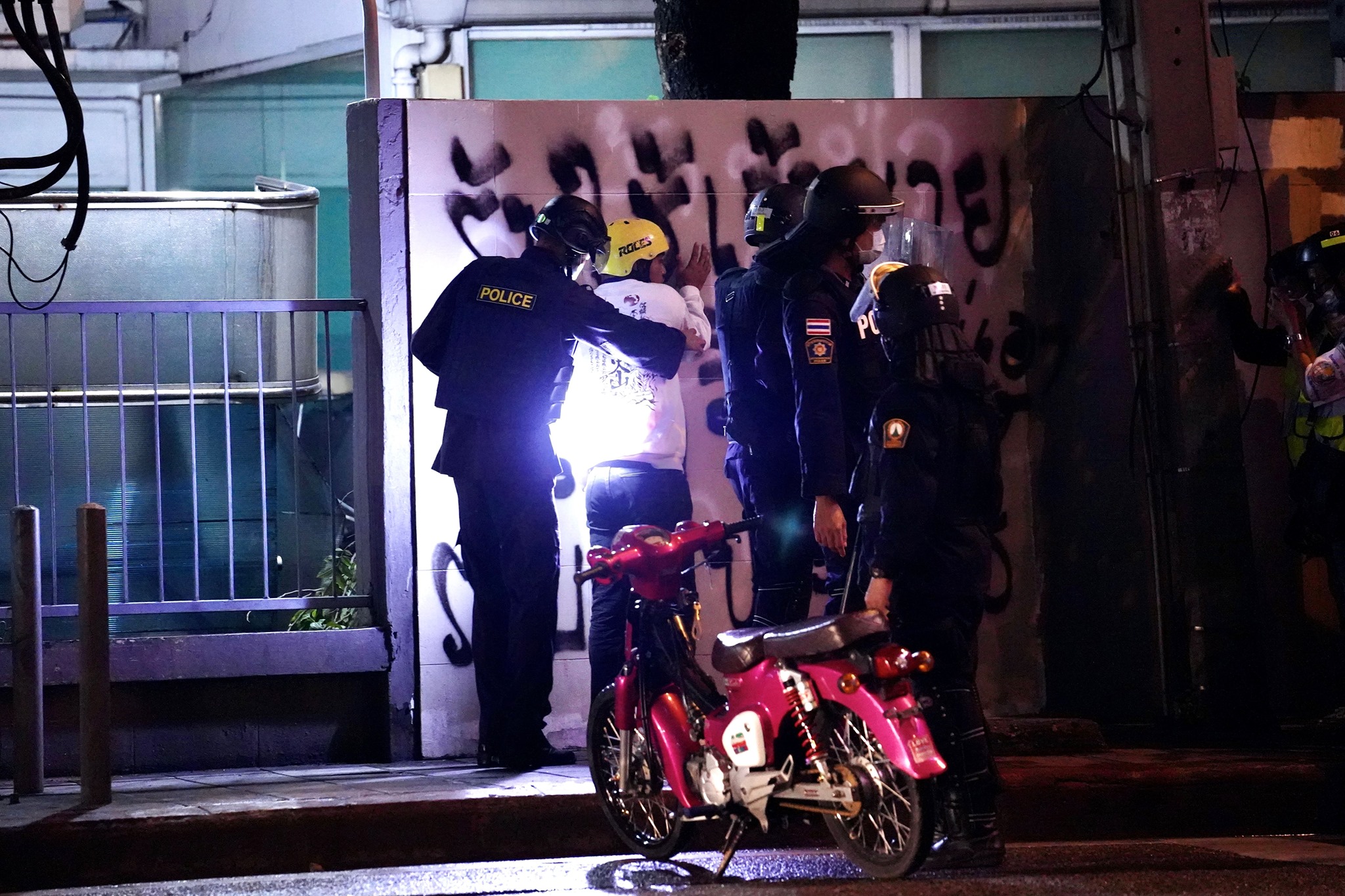
The dispersal of the public assembly on 6 October 2021. Photo by Prachatai.com
The dispersal of public assembly on 29 October 2021, as the officials clad in khaki color uniform kettled the protesters and arrested more than eight participants. Two children were released without charges. Three got injured from the public assemblies.
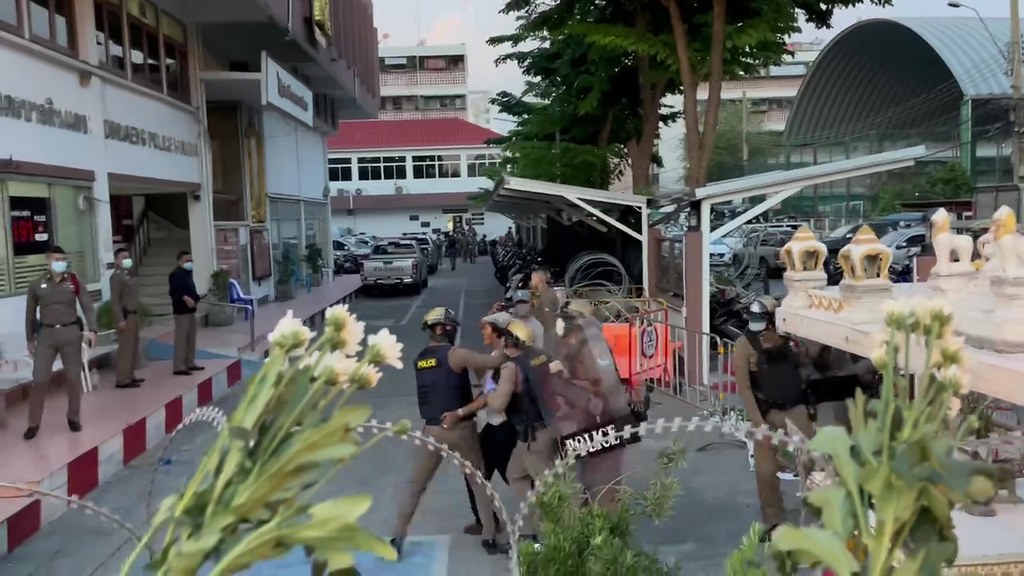
The arrest of demonstrators during the 29 October 2021 public assembly. Photo by Prachatai
Even though the number of public assemblies at the Din Daeng Intersection has declined, but the number of prosecution in their aftermath has risen. Some arrests were made with warrants, whereas others without, against suspects including in setting fire, vandalizing traffic police boxes, etc. Some who have been arrested from incidences related to Din Daeng have been denied bail, at least 16 of them including one 18-year-old-youth.
In addition, peaceful participants have been summoned to answer to charges concerning the violation of the Regulations issues by virtue of the Public Administration in Emergency Situations B.E. 2548 (2005). Some of them face several cases including a volunteer medic who was charged for violating the Emergency Decree for as many as 12 cases given his presence at the assembly venues . Moreover, the arrests appear to become more violent. During the dispersal of public assembly on 29 October 2021, a video taken by citizen media shows how the police officials physically abused individuals in their custody.
According to TLHR, 498 individuals have been arrested from the Din Daeng Intersection and its vicinity and they are charged in at least 167 cases.
Nature of crowd dispersal
How policing forces are deployed, the interval between the announcement and the dispersal of public assemblies, legal provisions invoked to state the alleged offences which have been used as a reason to demand restriction of public assemblies
In October 2021, the authorities have carried out at least five forceful dispersals of public assembly, all of which against the Thalugaz at the Din Daeng Intersection. It occurred at least four times from 1- 6 October 2021 and one on 29 October 2021 at the Din Daeng Police Station where the Free Youth were gathered to commemorate the death of a youth who had participated in the public assemblies and was shot on 16 August in front of the Din Daeng Police Station and later died on 28 October 2021.
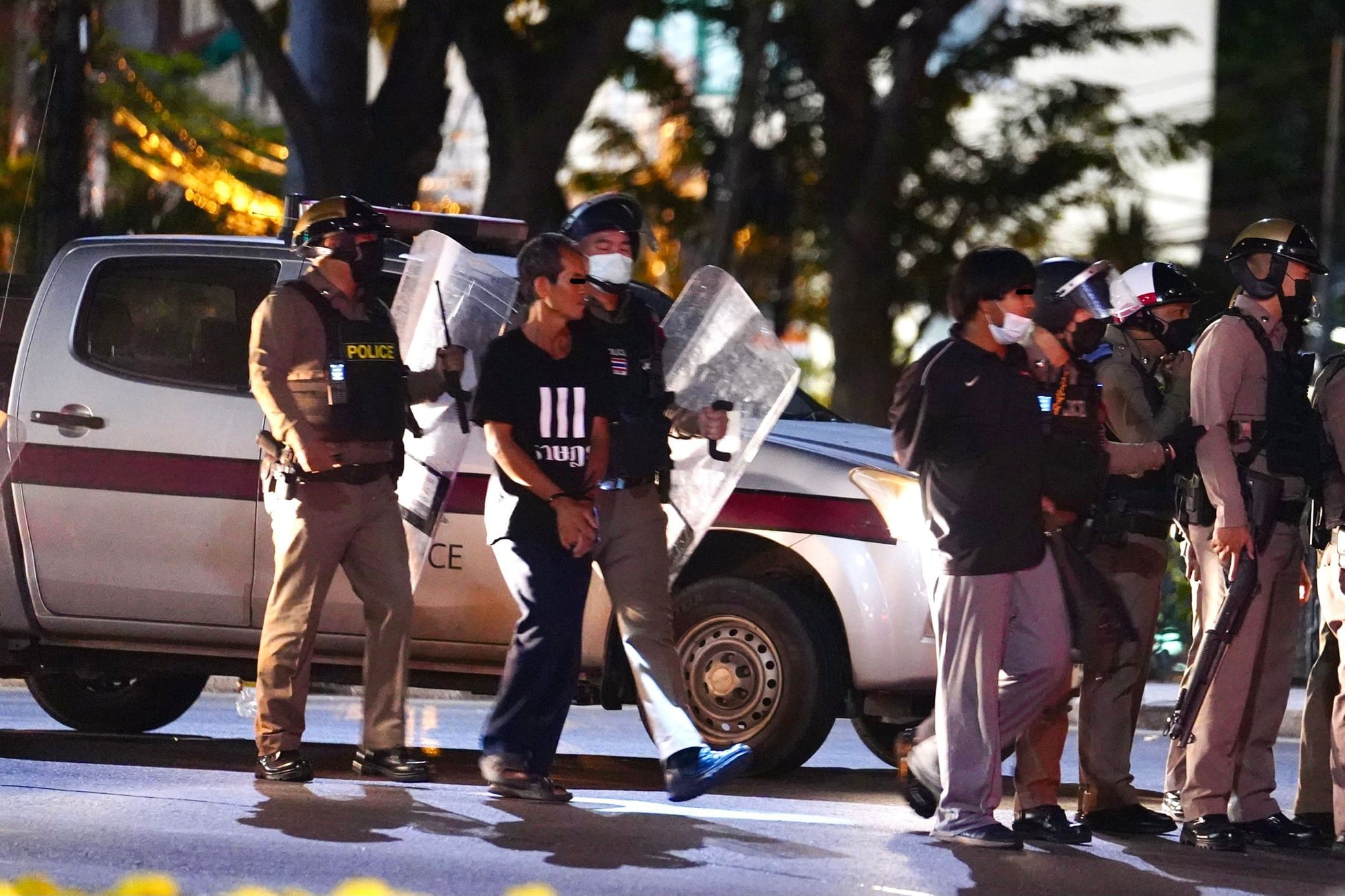
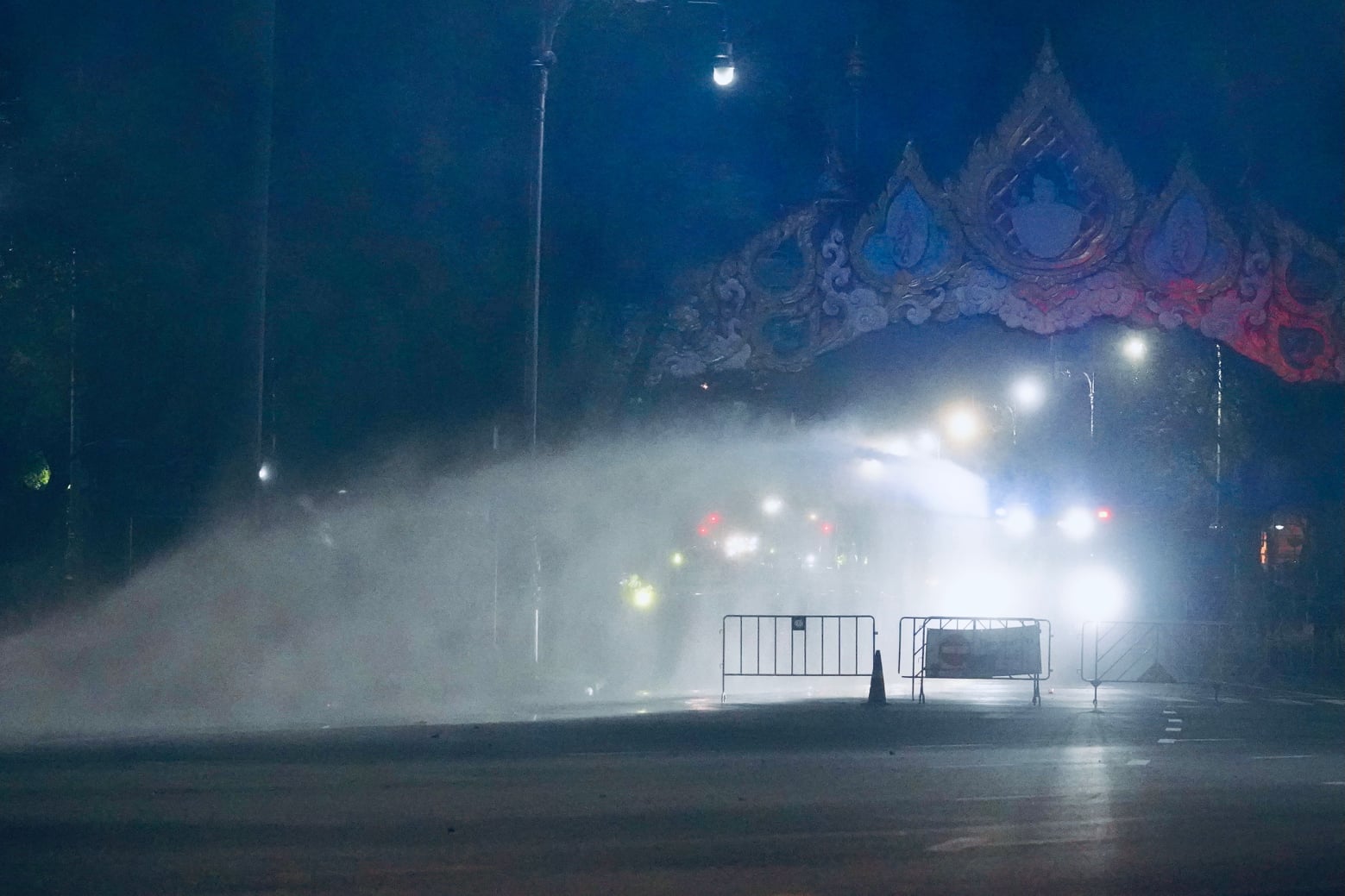
The dispersal of the public assembly on 9 October 2021. Photo by Prachatai.com
The nature of crowd dispersal during 1-6 October 2021 was similar to in September since the participants started to gather rather late at night (just before the curfew time, around 22.00). The main venue for the independent participants or the Thalugaz was Din Daeng Intersection, from in front of the Din Daeng Flat 1 on the outbound Vibhavadi Rd. at the Royal Thai Army Band Department and opposite to the Veterans General Hospital in Soit Mitra Maitree 1 intersecting with the inbound Vibhavadi Rd. When the independent participants were gathered, they often hurled objects including giant firecrackers, firework, and used slingshots targeting the crowd control officials. It drew response as the officials would retaliate by shooting at the participants with rubber bullet and tear gas to disperse the crowd. When the participants were gathered and hurled objects inside the Royal Thai Army Band Department, the officials would retaliate by firing rubber bullet and tear gas. As the curfew time arrived, the rapid units would be deployed and the crowd control officials hopped on the back of pickup trucks armed with rubber bullet guns and FN303 guns to kettle the protesters. This was similar to what happened during the public assemblies in September. Such operations, particularly the kettling and arrests, often cause impact on non-participants. And there have been reports of the use of crowd control equipment particularly, the firing of rubber bullet at a horizontal level and in close range and the use of tear gas at the assembly venues.
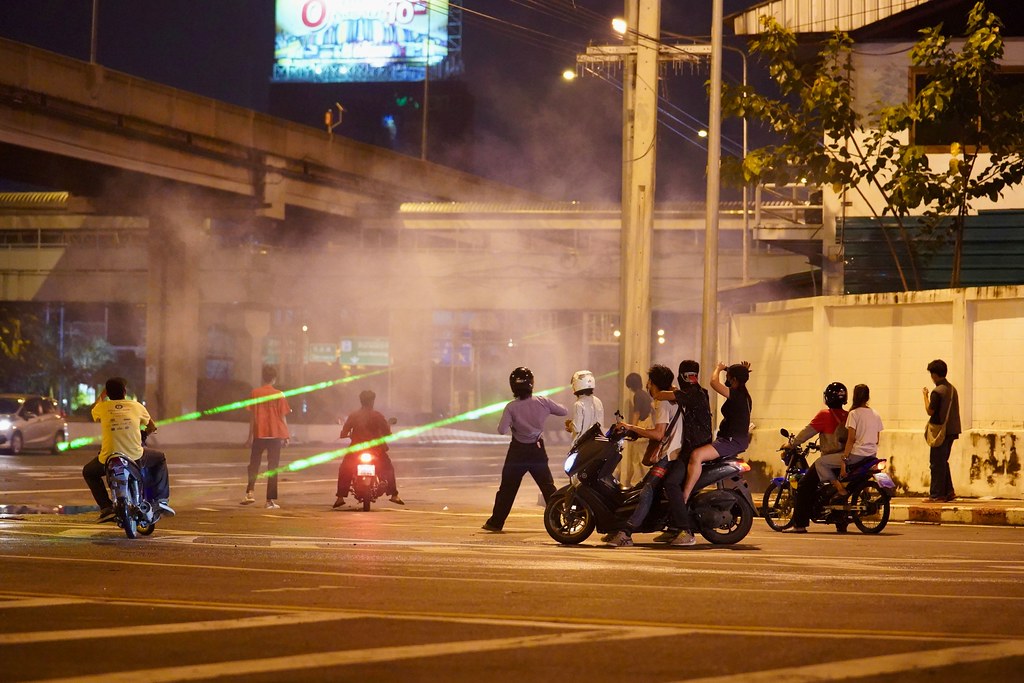
The dispersal of the public assembly on 2 October 2021. Photo by Prachatai
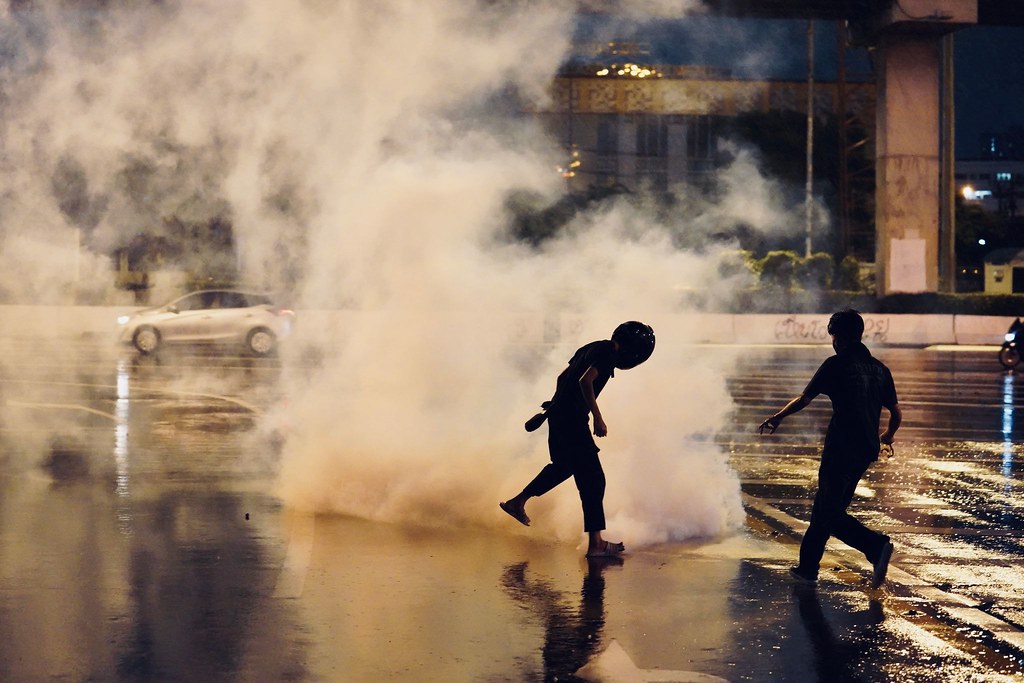
The dispersal of the public assembly on 3 October 2021. Photo by Prachatai
According to the General Comment no. 37, less-lethal weapons with wide-area effects, such as tear gas and water cannons, tend to have indiscriminate effects. When such weapons are used, all reasonable efforts should be made to limit risks, such as causing a stampede or harming bystanders. Such weapons should be used only as a measure of last resort, following a verbal warning, and with adequate opportunity given for assembly participants to disperse. Tear gas should not be used in confined spaces. Almost all the time the weapons were used, it was found the non-participants have suffered wider and sustained impact since these weapons should be used as the last resort after verbal warnings and the participants are given the proper opportunity. In October, according to information from on-site observation, there was no negotiation with the participants who were simply warned that their actions were against the law. The officials still held on to the attitude that the participants were perpetrators and thus there were negotiations between them.
Moreover, when kettling has been conducted indiscriminately and punitively, it violates the right of peaceful assembly, and may also violate other rights such as freedom from arbitrary detention and freedom of movement. The impact from mass arrests carried out against the participants attests to how the operations have been made clearly unnecessarily and disproportionately. The detail of each dispersal of public assembly which demonstrates a lack of necessity and proportionality can be described as follows;
During 1 – 5 October 2021, major events have escalated the situation at Din Daeng as the authorities continued to use violence unabatedly including the firing of rubber bullet which caused a wider impact. They even raided local residences at night to look for the escaping protesters. On 3 October 2021, it was reported that the officials pointed laser beam at the protesters and fired rubber bullets, tear gas and glass beads at them including at people not involved with the public assemblies who had to suffer from the impact of rubber bullets. And on 4 October 2021, around 00.00, some independent participants have returned to Soi Mitra Maitree 2 and aimed firework toward the flyover of the Vibhavadi plantation. Later on, a caravan of minivans without official logo and police trucks rapidly drove toward the Din Daeng Intersection where forces were deployed in front of the Din Daeng Flats as other officials moved toward the Din Daeng Flats. The raid and search in private residences have taken place two times prior to this including in August when the official controversially fired rubber bullets into a private place. It has prompted the National Police Chief, Pol Gen Suwat Jangyodsuk, to explain that there shall be no more raids in private residence. Nevertheless, the officials continued to raid the flats on 29 September 2021 and 4 October 2021.
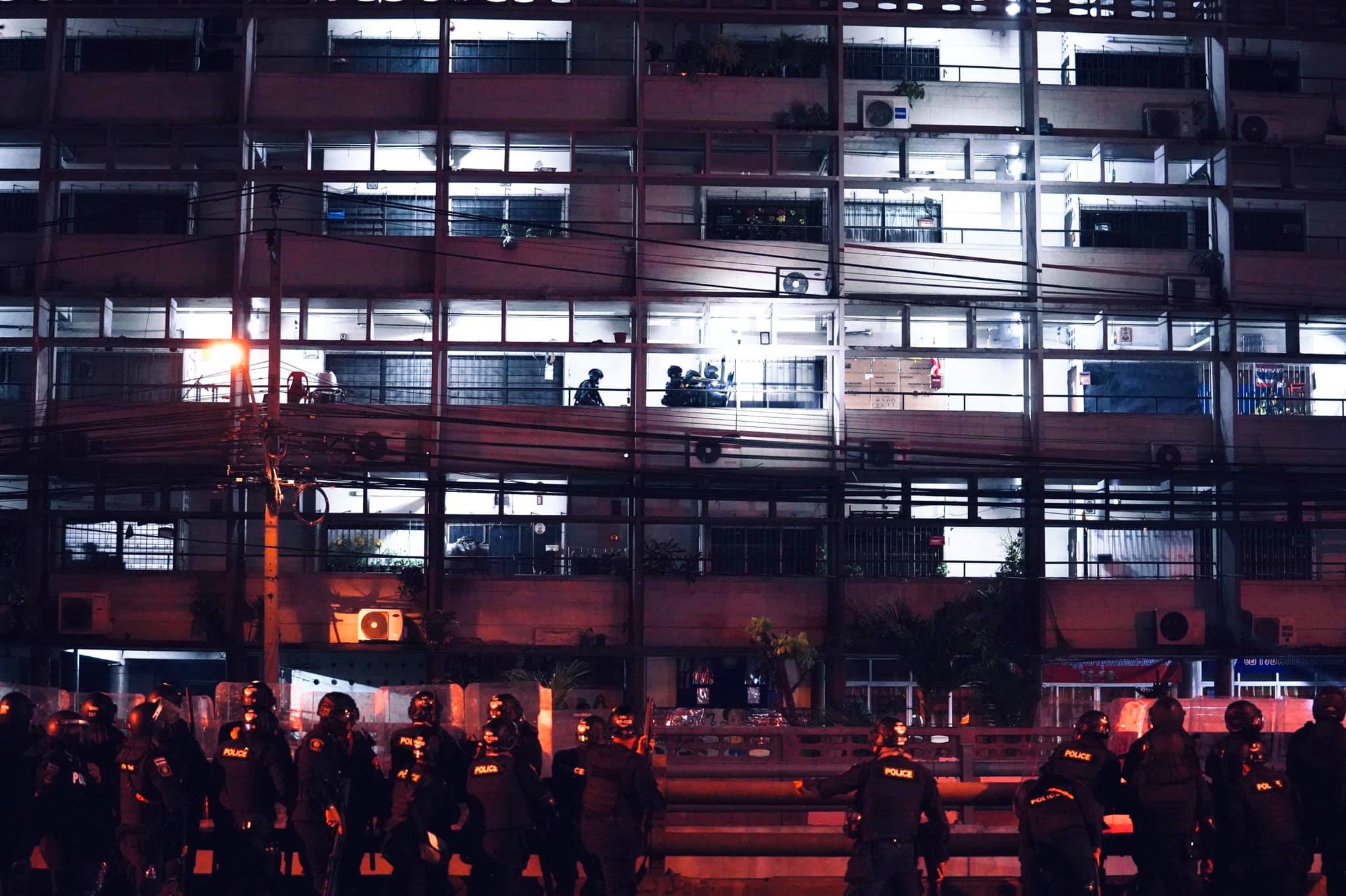
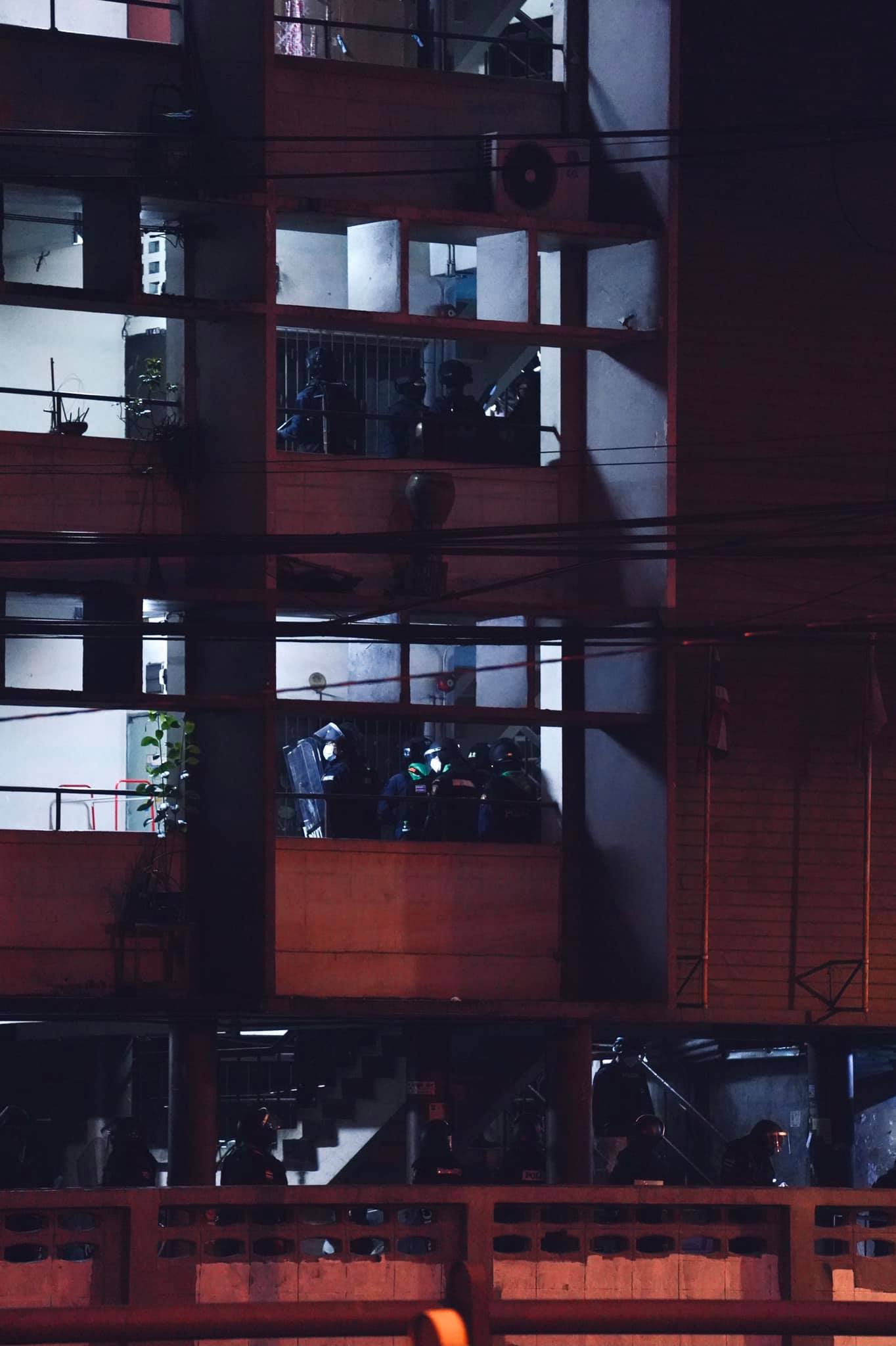
Forces were deployed in front of the Din Daeng Flats as other officials moved toward the Din Daeng Flats. Photo by Kai Maew Cheese
There was a fire on the third floor of the Din Daeng Flats on 1 October 2021 as captured in the livestreamed report of The Reporters around midnight of 2 October 2021. Members of the public, rescue workers and fire brigade successfully helped to put out the fire. Prior to the fire, noises of explosion were heard several times. Then, the fire started from a room on the third floor of the Din Daeng Flats before spreading out. It was eventually put under control and the room’s owners and those in adjacent rooms were rescued to safety.
Later during 6 – 7 October 2021, the independent participants would converge around 20.00 and hurled giant firecrackers and set fire on tires under the Din Daeng Expressway Intersection. Around 22.36, the rapid units would disperse the public assembly in front of the Din Daeng Flats by cordoning off the Pracha Songkhao Rd. and the Mitra Maitree Rd. as well as the Din Daeng Intersection and sealing off a small road connected to the Din Daeng Flats. The arrests were made inside Soi Ton Poh by the Din Daeng Flats. The officials shined the light toward the reporters who were performing their duties. Meanwhile, the officials armed with shields would push the reporters away from in front of the Din Daeng Flats. Around 23.15, an official of the Protection and Crowd Control Division and a crowd control official was hit in his head with a live bullet which penetrated through the helmet while performing his duties at an apartment inside Soi Din Daeng 1. As a result, forces were deployed for kittling in Din Daeng Flats since early evening on 6 October until noon of 7 October. According to the livestreamed report of The Reporters, the special forces of police have raided the area in front of the Din Daeng Flats and this has led to as many as 70 arrests against the protesters and citizen media including Live Real Page while livestreaming ใin Soi Ton Poh by the Din Daeng Flats. After 7 October, Gen Jirasant Kaewsaengake, deputy chief of the Metropolitan Police, explained that an offensive operation shall be adopted with the officials to seize and control the area. The suppression units armed with pistols will be deployed to prevent any public gathering. The tactical change has given rise to the gatherings of independent groups including the Thalugaz since 7 October. Meanwhile, retrospective arrests and prosecutions have constantly been made against participants of the public assemblies including the Thalugaz sending the number of Thalugaz participants being arrested to reach 498 persons in at least 167 cases in August 2021.

Forces were deployed for kittling in Din Daeng Flats since early evening on 6 October until noon of 7 October. Benar News
Toward the end of October, since the Free Youth has announced its rally on 29 October 2021 at the Din Daeng Police Station to commemorate the passing of a youth who was shot in the public assemblies in August and later died on 28 October. The participants were gathered for a candle vigil at the spot where the child was shot. Later, some participants organized an activity to burn paper at the spirit house of the Din Daeng Police Station. It prompted the officials to put the fire out using extinguisher and announced that the participants were breaking the law issued pursuant to the State of Emergency and were committing a offence of arson. About 5-10 minutes later, about one company of police officials in khaki uniform with shields and rubber bullet guns were deployed at the Mitra Maitree Rd. and they were charging in to arrest at least three protesters. They also kettled the protesters in front of the Din Daeng Police Station again driving in more than seven vehicles of the Metropolitan Police Bureau’s special operation patrol unit before letting the participants to leave. After the kittling to push out some participants from in front of the Din Daeng Police Station and the ensuing clashes with the police officials in Soi Pracha Songkhao 12, tear gas and rubber bullets were fired into the adjacent area causing an injury against a seller of meatball whose vehicle was hit with rubber bullet until the mirror was broken. Two other residents were hit with rubber bullets. Around 22.30, the khaki uniform officials and the SWAT team have raided the area on the Pracha Songkhao Rd. in front of the Din Daeng Police Station. In addition, the police also seized the mobile phones of a reporter of the Katoey Mae Look On facebook page. It was the second time that the Katoey Mae Look On facebook page’s reporters faced such harassment. The first time took place in the middle of September during the livestreaming at the Din Daeng Intersection. In addition, the officials have invited reporters from various news outlets for a walk inside the Din Daeng Police Station during which time they were not allowed to livestream.
In addition, during the crowd dispersal on 29 October 2021, a citizen media took a video while police officials were committing physical abuse against a person in custody. Later on, Piyarat "Toto" Chongthep' from the We Volunteer and the injured person have submitted a letter of complaint to the House Committee on Legal Affairs, Justice and Human Rights. According to the injured person, he was there to participate the commemoration. As the crowd dispersal started, he tried to run away, but was nabbed. While in custody, he was pushed toward a vehicle and as he fell down, several police officials, in uniform and plainclothes, have grabbed him by his arms, legs and neck and dragged him inside the fences of the Din Daeng Police Station. Once he was pushed into a closed room, the officials asked him “How could you get here? Have you come with anyone else? Are you here by yourself? You think you are just damn good?”. The continued that “Well, we would just make it looks like you died from an accidence.” Then, they just physically abused him by kicking at his body, hitting him in his right ribs with a truncheon, grabbing his head and hitting it against the chair several times, and strangling him to force him to divulge his phone lock code. As he could not remember, since he opened it by finger scanning and as he gave them an incorrect code, he was further strangled until he nearly passed out.
The use of weapons and equipment by the officials during the public assembly dispersal and suppression including water cannon, tear gas, rubber bullets
The interval between the announcement of crowd dispersal and its commencement, the order of the use of weapons and equipment in crowd dispersal, how the weapons and equipment are used against the protesters, the trajectory and the range of the shooting, the targets, the number of injuries, nature of such injuries (if any)
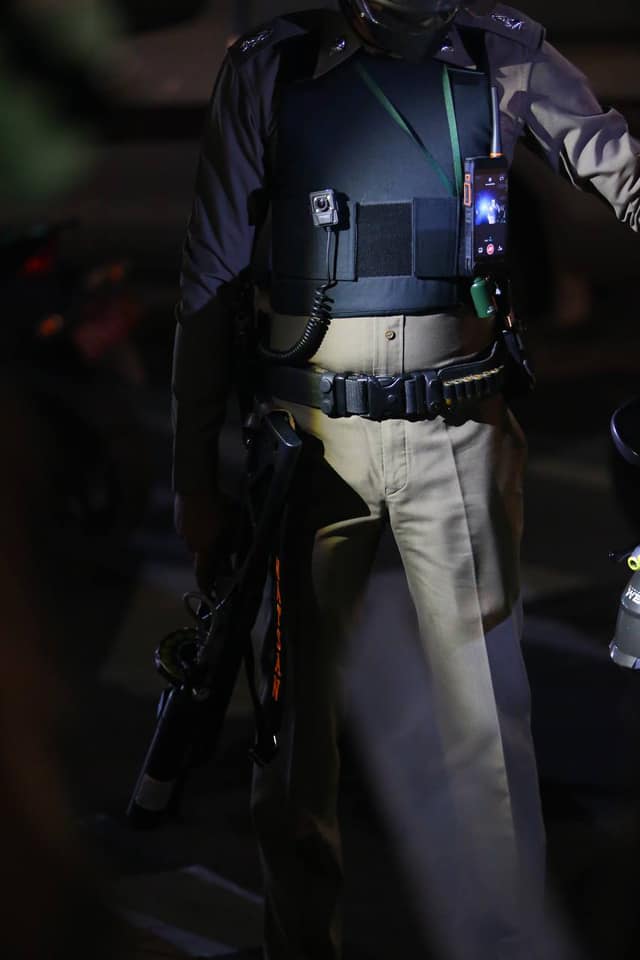
Photo by iLaw
During a series of public assemblies by the Thalugaz, the officials would often make an announcement for the participants to stop such public assemblies and other actions including hurling giant firecrackers, using slingshots, hurling tennis ball bombs at the lines of the police accusing it as an illegal action. They often refer to the participants as perpetrators and would disperse the crowd as the curfew time approached. As to the firing of rubber bullets, they have been mostly fired at close range. In addition, The FN303 guns were found to have been used in September in the assembly venues of every assembly. On 7 October 2021, the Deputy police spokesman Pol Colonel Krisana Pattanajaroen gave an interview after being asked about the use of FN303 guns. The reporters have said that police officials in Boston, USA, have already stopped using the guns since shots have been fired from such guns into the eye socket of a protest causing the person to die from the projectile that penetrated the brain..33 The Deputy police spokesman Pol Colonel Krisana Pattanajaroen replied that “The equipment has been procured for use to main public order. If the public assemblies occur peacefully. During the crowd policing, the officials would use such equipment since it is considered a less-lethal weapon. "But since the public assemblies here occur unpeacefully, and of course we cannot choose to use live bullets, we have to resort to use the equipment adopted by the crowd control officials. And it has been used following the law and international standards with proportionality.”
How the officials respond to children and youth in the protesting site
If children or youth were held in custody, please indicate the measures adopted by the officials when carrying out the arrests. Have there been children or youth who got injured during the arrest? Explain in brief the charges against them, the detention facilities, other rights of the child including the right to meet with their parents, the right to medical treatment and the right to meet with their legal counsel

The dispersal of the public assembly on 6 October 2021. Photo by Prachatai.com
In the Convention on the Rights of the Child to which Thailand is a state party, it stipulates that the right of the child when being arrested as every child deprived of liberty shall be treated with humanity and respect for the inherent dignity of the human person and their best interest. They shall be treated differently from adults and the children and youth prosecuted shall be held in custody at the shortest time possible. In addition, no child shall be deprived of liberty unlawfully or arbitrarily. The arrest or deprive of liberty of a child shall be conducted in accordance with law and it shall be used as the last resort and at the minimum time.
Thailand’s domestic legal provisions on the rights of the are included in the Juvenile and Family Court and Procedure Act which prescribes the general criteria for the arrest of children and youth as follows;
1. Section 67 prescribes that when the Court considers issuing an arrest warrant against a child or juvenile alleged to have committed an offence, the Court shall pay special attention to the protection of the rights of child or juvenile. The Juvenile and Family Court Act’s Section 66 prescribes essentially a child from 10 but not more than 15 years can only be arrested when such child commits a flagrant offence or have an arrest warrant or court order made against him or her. As to youth older than 15 years, but not more than 18, compliance with the Penal Code must be made similar to the treatment of adults. Arrest warrants must have been issued. If the arrest made without warrants, it has to be a flagrant offence or when it is suspicious that the person is about to commit a harm or it is urgently required, Otherwise, it means the arrest of a person who absconded after being discharged.
2. Upon holding the children and youth in custody, the police must inform them that they are being arrested, explained to them the charges and their legal rights. Should there be a warrant issued by the court, it has to be produced to the arrestee who shall then be transferred to the police station of jurisdiction immediately. The Juvenile and Family Court Act sets out further guidelines in Section 69/3 and how the police should make the arrest and the holding in custody without using violence and shaming them as well as refraining from using restraints. Section 76 further provides that the arresting officials or the inquiry officials r shall not provide, permit or agree to have any photo taking or video recording such child or juvenile who is alleged to have committed an offence except for the purpose of the inquiry to protect their right to privacy. As the arrests of children and youth this month, there have been arrests made for flagrant offences stemming from their participation in the public assemblies in Din Daeng. There have also been reports of the use of violence disproportionately during the arrests including the firing of rubber bullets, hitting the head with gun handle, burning with cigarette butt, etc. In addition, the persons under arrest have neither been informed of the charges against them nor their legal rights as a suspect. Their phones have even been seized during the arrests depriving the children and youth of the ability to contact their lawyers or confidante. The injured children or youth have also been transferred to the police station right away, instead of the hospital. In addition, after being arrested, they have been taken to a place which was not a police station of jurisdiction for custody including the Narcotics Suppression Bureau, even though such act is not permitted by law. Also, their detention places have been changed without notifying their lawyers.
3. Restraints should be used for holding a child in custody and they should be detained separate from adults. In fact, no one should be deprived of liberty and the multidisciplinary team must be involved with the detention since the beginning.40 When the children or youth have been brought to the inquiry officials, their parents should be present during the procedure. The interview should be conducted in an appropriate place and they should not be interviewed with other suspects and people not concerned with the case. After the interview, the children or youth must be brought to the court within 24 hours for an arrangement to review the arrest, since the time when the child was first arrested. If deemed fit by the inquiry officials that the legal custodians of the children or youth are able to look after them, they shall be allowed to bring the children or youth to the court within 24 hours.
But in reality, it was found that during the dispersal of public assembly on 6 October, the Thai Lawyers for Human Rights (TLHR) described in its report that the police officials denied the suspects’ access to their lawyers including youth for 12 hours. This is tantamount the infringement on the rights of the suspects to have private access to their lawyers.41
Any measures by the Juvenile and Family Court (if any), the bail amount, etc.
When the children or youth are present in the court, the judges shall review if the children or youth have commited the offences as alleged or not, and to review if the arrest and treatment of the children or youth have been carried out lawfully or not. If found unlawful, the children or youth have to be released from custody. The Juvenile and Family Court Act does not, however, states what to do if the custodians have failed to bring the children or youth to the court within 24 hours.
In this month, the police officials have held the children and youth in custody longer than 24 hours and the court could not review the lawfulness of the arrest. The court, however, had another hearing to review the arrest and eventually ruled that it has been carried out lawfully. The key criteria for the bail of children and youth is their guarantors must be their parents, or their custodians, or their siblings, or other persons authorized by their parents or custodians. A problem occured when the children and youth under arrest had no parents to act as their guarantors and they end up being held in custody at the Juvenile Detention Centre. During the public assemblies in Din Daeng on 8 October 2021, two of the three minors arrested were not bailed since their parents have failed to be present at the court. One of them is a Myanmar youth who was also deaf. There needed to be more documents to have them bailed. As a result, they were brought to the Juvenile Detention Centre. At present, they have been bailed.
Response of the officials toward media and observers during the assemblies
Policies-statements of the Royal Thai Police and the Metropolitan Police Bureau (if any) toward the performance of duties of media
Throughout the public assemblies in 2021, there were at least 1,361 assemblies (as of 6 November 2021) and the crowd dispersal is still a common tactic used by the authorities, particularly during the public assemblies in Din Daeng in the past August. This has escalated the situation of violence abetted by either the authorities or the protesters. Media and monitors play an important role in fact-finding, although they tend to face more restriction and confinement in various forms. For example, more requirements are imposed on them while present at the assembly venues, the requirement of press armbands issued by the Royal Thai Police, press passes and licenses to work during the curfew time. During their work, the media have often been instructed to desert the assembly venues or confined to a certain area citing security need.
Media and monitors of public assemblies warrant protection from the state according to the ICCPR. In addition, according to the UN Human Rights Committee’s General Comment no. 37, they must not face reprisals or other harassment, and their equipment must not be confiscated or damaged. Even if an assembly is declared unlawful or is dispersed, that does not terminate the right to monitor.
Since August, the Metropolitan Police Bureau has had a consultation with media organizations concerning the symbol of the press and other organizations present at the assembly venues. Despite the use of the symbols, media continued to face harassment while performing their duties, particularly during the curfew time. As a result on 12 September 2021, six media organizations including the Thai Journalists Association (TJA), the Thai Broadcast Journalists Association (Thaibja), the Online News Provider Association and the National Union of Journalists Thailand (NUJT) have coordinated with the police and were informed by the Pol Maj Gen Piya Tawichai, Deputy Commissioner of the Metropolitan Police Bureau that media present during the curfew time to report and livestream are required to meet some requirements mutually agreed between the professional media organizations and the Royal Thai Police. They must have press passes with clear affiliation, armbands issued by the six media organizations, and letters of certification from their affiliated organizations to certify the need to work and travel during the curfew time.
The requirements of armbands and media affiliation coupled with the Metropolitan Police Bureau’s often accusation of protesters disguising themselves as reporters in the assembly venues were attested to by an interview by Pol Maj Gen Piya Tawichai, Deputy Commissioner of the Metropolitan Police Bureau and its spokesperson that media are allowed to work during the curfew time. The police only push out media without affiliation. In addition, the police officials tend to harbor a stereotypical view toward the citizen media or freelance online media accusing them of being part of the protesters. As a result the citizen media or freelance media have been targeted and subject to the arrests and charges twice in September. In October, the media were still prohibited from working and the citizen media continued to face harassment. For example, on 6 October 2021, the police arrested Admin Ninja of Live Real Page while livestreaming the incidence at Soi Ton Poh by the Din Daeng Flats. He was accused of breaking curfew ban. On the same day, the reporter of The Reporters was also told by the police to stop working and was accused of reporting to expose the whereabouts of the police to the protesters. The reporter denied such accusation and explained that he just started the livestreaming when the kettled the protesters in front of the Din Daeng Flats. In addition, on 29 October 2021, after the crowd dispersal, around 23.00, the citizen media including the Katoey Mae Look On facebook page had their mobile phones seized by the police. And around 00.00, other media were also asked to have a talk regarding how to cooperate at the Din Daeng Police Station and were barred form livestreaming while discussing.
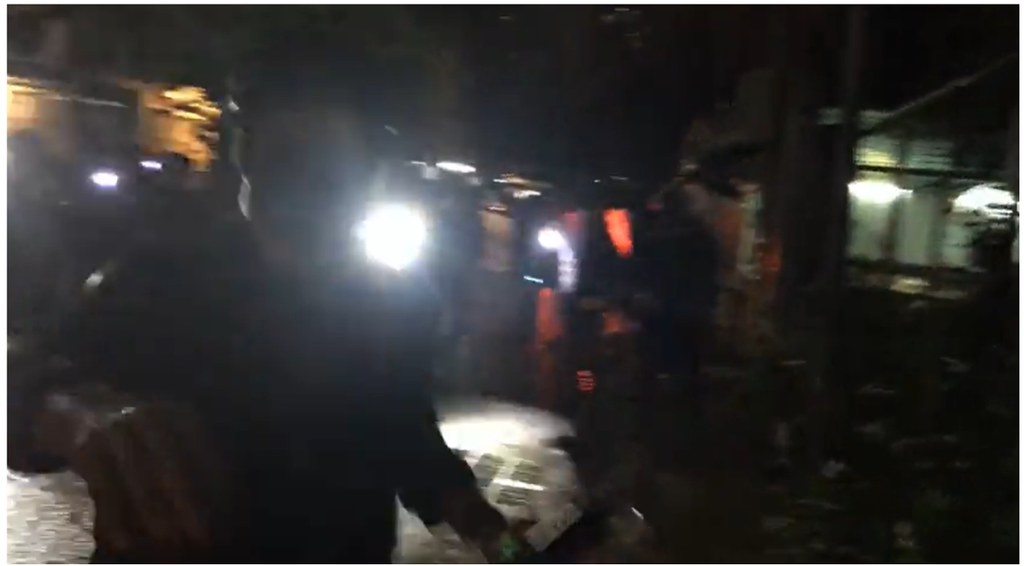
On 6 October 2021, the police arrested Admin Ninja of Live Real Page while livestreaming the incidence at Soi Ton Poh by the Din Daeng Flats. Photo by Prachatai
Has there been any use of weapons or equipment including rubber bullet, tear gas, water cannon, etc. against media or monitors?
On 29 October 2021, the crowd control units kettled the protesters in front of the Din Daeng Police Station. It appears the police officials aiming their shotguns at the media at close range late at night at the Pracha Songkhao Intersection. Freelance media were hit with rubber bullets despite their indicating their press status. Nevertheless, It was unclear as to the number of freelance media affected by the use of crowd control equipment.
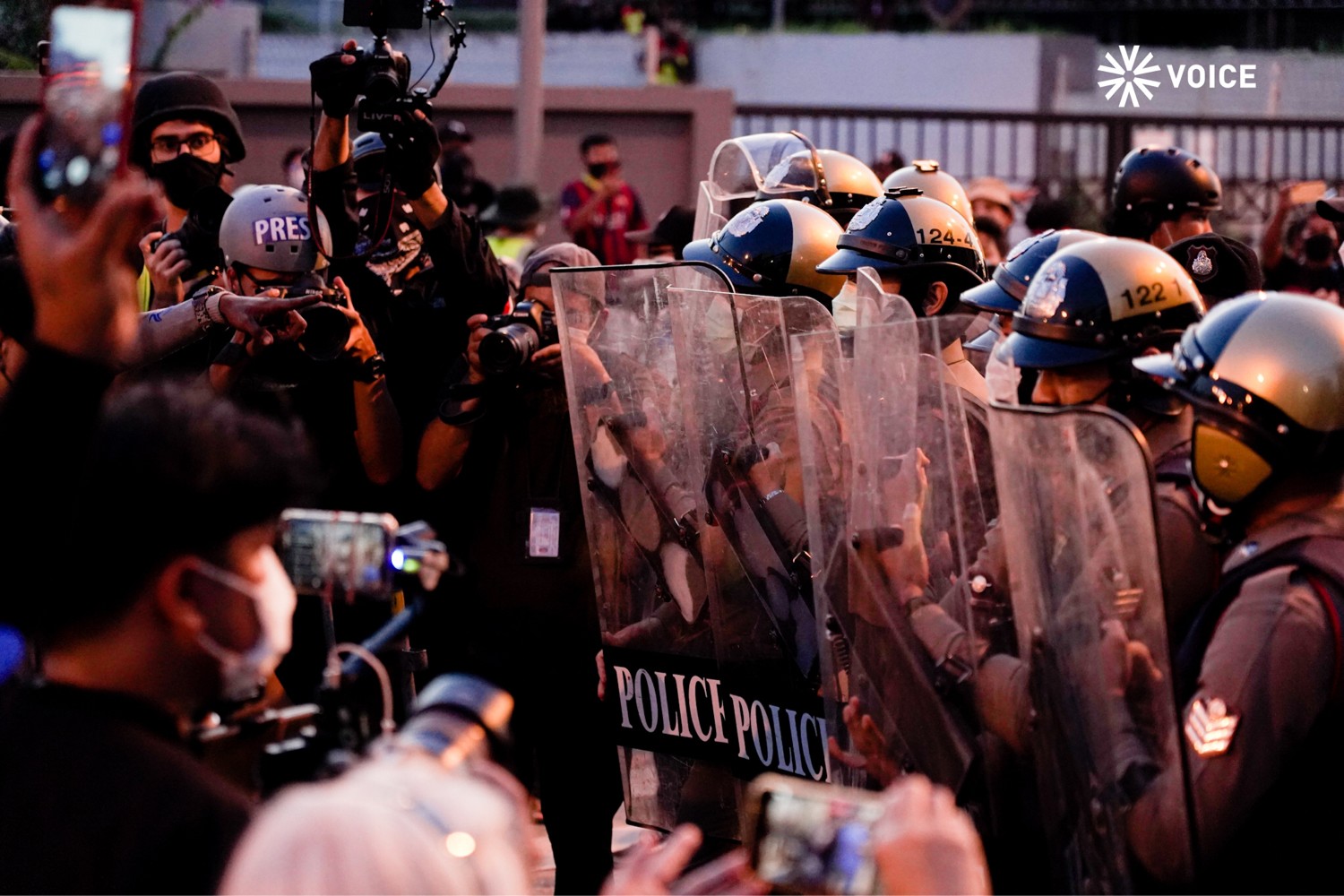
On 29 October 2021, the crowd control units kettled the protesters in front of the Din Daeng Police Station. Voice TV
